

Clearfix: A Lesson in Web Development Evolution. Share this: Ship custom analytics today with Keen.io.

The web community has, for the most part, been a spectacularly open place. As such, a lot of the best development techniques happen right out in the open, on blogs and in forums, evolving as they’re passed around and improved. I thought it might be fun (and fascinating) to actually follow this creative exchange all the way through. The end of the clearfix hack? Let's keep in touch A low traffic email list, keep up to date with where I am and what I've published.
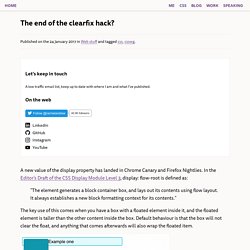
A new value of the display property has landed in Chrome Canary and Firefox Nightlies. In the Editor’s Draft of the CSS Display Module Level 3, display: flow-root is defined as: “The element generates a block container box, and lays out its contents using flow layout. It always establishes a new block formatting context for its contents.” The key use of this comes when you have a box with a floated element inside it, and the floated element is taller than the other content inside the box. The floated element is out of flow causing the box to collapse. The end of the clearfix hack? Display: flow-root; Share this: Ship custom analytics today with Keen.io.
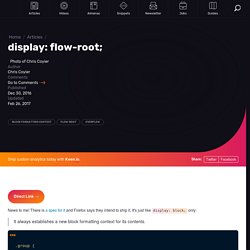
Direct Link → News to me! There is a spec for it and Firefox says they intend to ship it. Better float containment in IE using CSS expressions. Research into improving the cross-browser consistency of both the “clearfix” and “overflow:hidden” methods of containing floats.
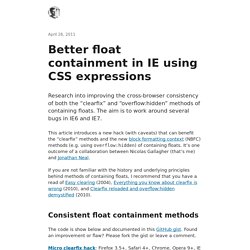
The aim is to work around several bugs in IE6 and IE7. A new micro clearfix hack. The clearfix hack is a popular way to contain floats without resorting to using presentational markup.
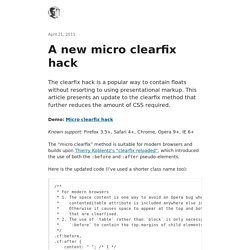
This article presents an update to the clearfix method that further reduces the amount of CSS required. Demo: Micro clearfix hack Known support: Firefox 3.5+, Safari 4+, Chrome, Opera 9+, IE 6+ The Clearfix: Force an Element To Self-Clear its Children. Share this: Ship custom analytics today with Keen.io.
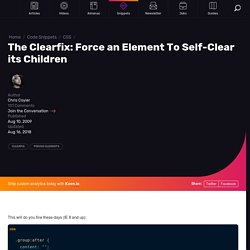
This will do you fine these days (IE 8 and up): Apply it to any parent element in which you need to clear the floats. For example: The Clearfix: Force an Element To Self-Clear its Children. Clearing a float container without source markup. (This clearing technique was developed by Tony Aslett, of csscreator.com.
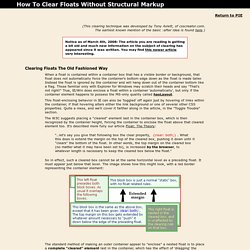
The earliest known mention of the basic :after idea is found here.) Notice as of March 4th, 2008: The article you are reading is getting a bit old and much new information on the subject of clearing has appeared since it was written. Créer plusieurs colonnes de même hauteur en HTML et CSS. Les 30 Sélecteurs CSS à Absolument Connaître. 1,200+ courses and ebooks Design, code, video editing, business, and much more.
Adobe Photoshop, Illustrator and InDesignGraphic, Logo and Print DesignSketch, Adobe XD & FigmaWordPressJavascript, PHP & PythonAdobe After Effects & Premiere ProMuch More Millions of creative assets Design templates, stock videos, photos & audio, and much more. Graphic TemplatesStock PhotosMusic TracksVideo TemplatesWeb TemplatesDesign AssetsWordpress Themes & PluginsMuch More 1,200+ courses and ebooks Design, code, video editing, business, and much more. Adobe Photoshop, Illustrator and InDesignGraphic, Logo and Print DesignSketch, Adobe XD & FigmaWordPressJavascript, PHP & PythonAdobe After Effects & Premiere ProMuch More Millions of creative assets Design templates, stock videos, photos & audio, and much more. CSS float. One of the basic and the most important properties every web designer should learn is the float property.

It is most commonly used for floating text around the image or creating the two column layout. The float property can cause a lot of frustration and confusion if it’s not fully understood, so we’re here to make those confusions disappear with this short explanation. Also, be sure to check out our articles on some other properties, other than CSS float, that often cause confusion like css columns or relative font size. The definition. CSS - le hack clearfix. The very latest clearfix reloaded. Over 3 years ago I wrote "The very latest new new way to do “clearfix”.
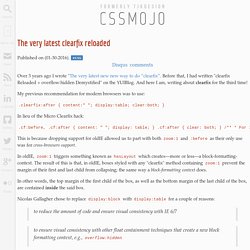
Before that, I had written "clearfix Reloaded + overflow:hidden Demystified" on the YUIBlog. And here I am, writing about clearfix for the third time! Le contexte de formatage block en CSS - Alsacreations. Certaines spécifications CSS sont plus obscures que d'autres.
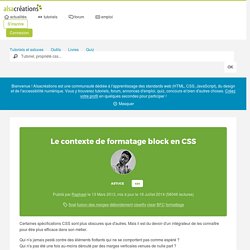
Mais il est du devoir d'un intégrateur de les connaître pour être plus efficace dans son métier. Qui n'a jamais pesté contre des éléments flottants qui ne se comportent pas comme espéré ? Qui n'a pas été une fois au-moins dérouté par des marges verticales venues de nulle part ? Ces comportements, comme d'autres, sont décrits et expliqués au sein d'une spécification concernant le “Visual Formatting Model”, qui décrit globalement le concept de flux d’affichage, de boîtes et de modes de rendu visuel. Better float containment in IE using CSS expressions. Clearfix Reloaded + overflow:hidden Demystified. Clearfix and overflow:hidden may be the two most popular techniques to clear floats without structural markup. This short article is about enhancing the first method and shedding some light on the real meaning of the second. clearfix In everything you know about clearfix is wrong I explain the issues this method creates across browsers and I suggest to only use clearfix on elements that are not next to floats (e.g. a modal window), although as authors we still have to deal with collapsing margins.
This demo page demonstrates the issue. Margin-collapse behavior in the first two boxes shows that it is the generated (non-empty) content that keeps the bottom margin inside the box (which makes perfect sense according to spec). A new micro clearfix hack. Html - What is a clearfix? The Clearfix: Force an Element To Self-Clear its Children. All About Floats. By Chris Coyier On What is "Float"? Float is a CSS positioning property. To understand its purpose and origin, we can look to print design. In a print layout, images may be set into the page such that text wraps around them as needed.
This is commonly and appropriately called "text wrap". In page layout programs, the boxes that hold the text can be told to honor the text wrap, or to ignore it. In web design, page elements with the CSS float property applied to them are just like the images in the print layout where the text flows around them. Initiation au positionnement CSS : 2.position float. La position float retire une boîte du flux normal pour la placer le plus à droite ou le plus gauche possible dans son conteneur. Comment l’utiliser dans une mise en page CSS ? Comment fonctionne CSS Float. Inline-block est-il un substitut aux floats ?
Par Steven Bradley Quand vient le moment de développer la mise en page avec CSS, float fait le plus gros du travail. All About Floats. Clearing a float container without source markup. CSS - Clearing floats. Page last changed today A common problem with float-based layouts is that the floats' container doesn't want to stretch up to accomodate the floats. If you want to add, say, a border around all floats (ie. a border around the container) you'll have to command the browsers somehow to stretch up the container all the way. Let's try it. Empêcher les flottants de dépasser de leur conteneur. Par défaut dans les navigateurs, les éléments positionnés grâce à la propriété CSS float (aussi appelés flottants, ou en anglais floats) sortent du flux de leur conteneur. Autrement dit, les flottants «dépassent». C'est ainsi qu'on se retrouve avec des conteneurs qui font zéro pixel de hauteur, des colonnes qui passent à travers un pied de page, et autres résultats peu souhaitables.
Par exemple, avec ce code HTML et CSS les «colonnes» flottantes dépasseront de leur conteneur: Contained Floats, the clearfix technique. Author: Tony Aslett First created 8-May-2004 There is a large and growing movement by web developers and designers towards web standards. Part of that movement focuses on clean mark-up, which has many long term benefits such as easier maintenance, lighter pages and better support by browsers of the future.
One thing that has bugged me was the need to add clearing elements to the mark-up to keep a container wrapped around a floated element. Most people use a division, horizontal rule or a break and set it to clear both to keep the container around the float. Well now there's another way that will free us from the need to add extra clearing elements. Clearing a float container without source markup.